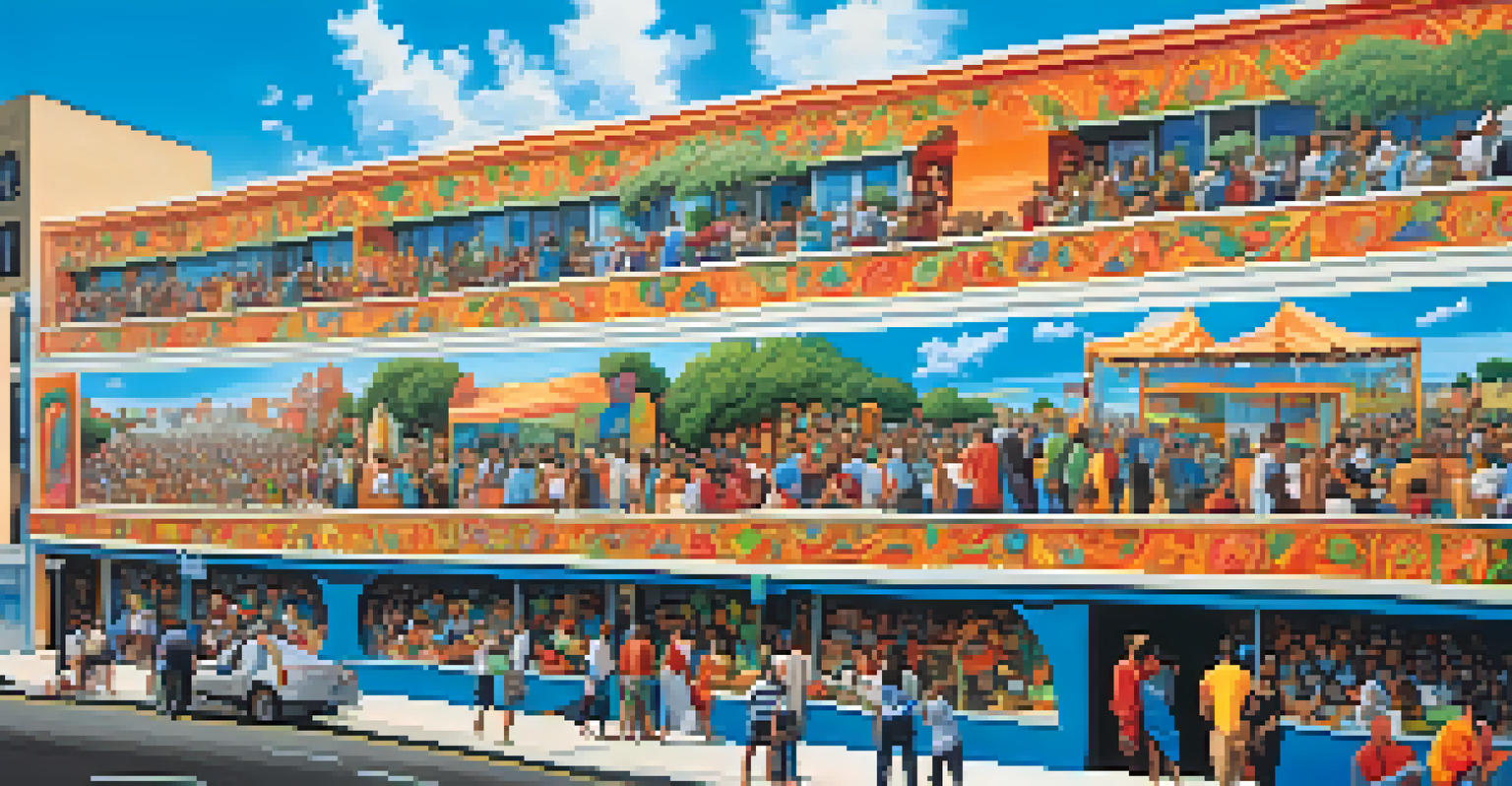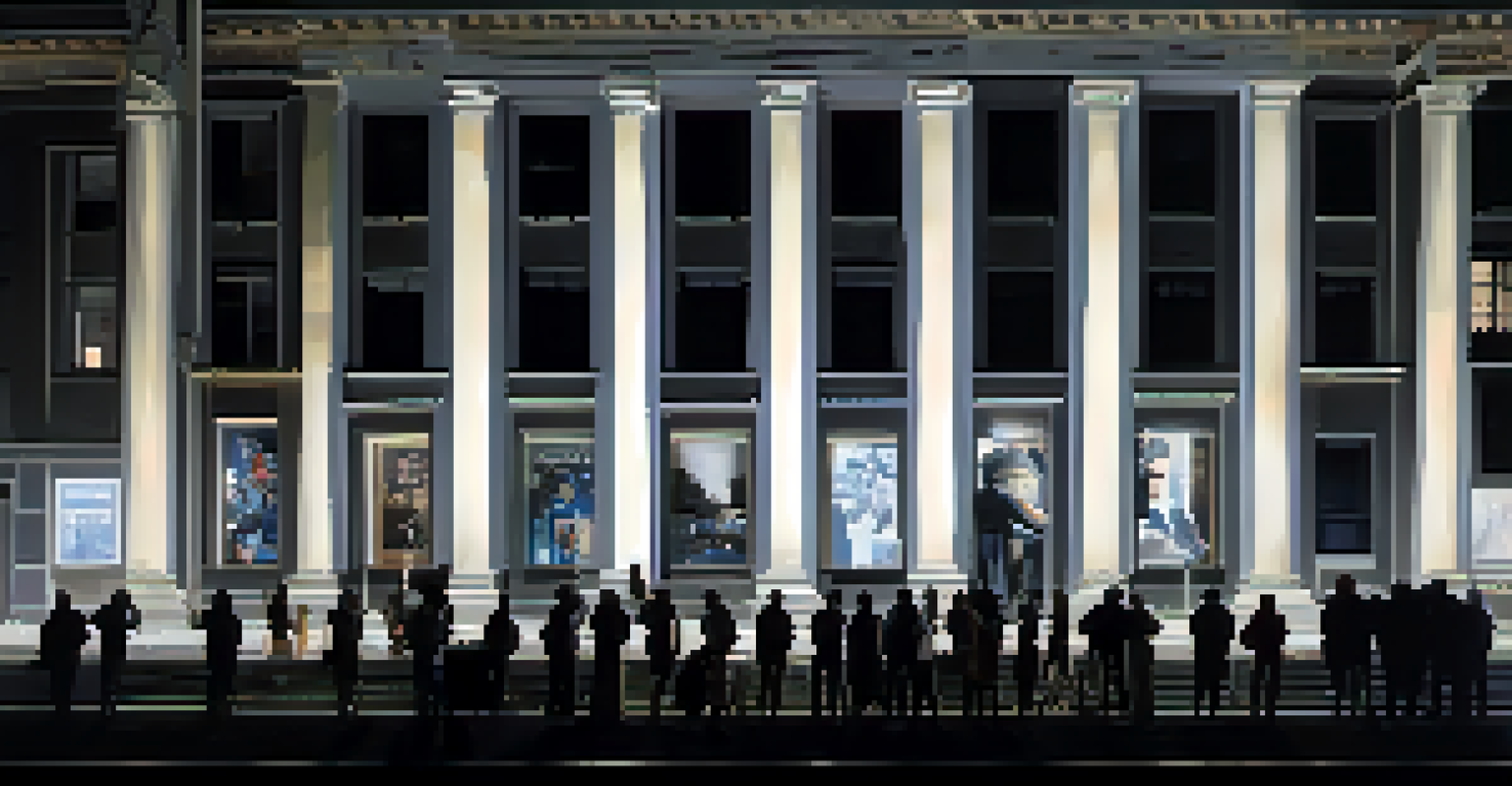Friezes: The Storytelling Element in Architectural Design

What Are Friezes? A Quick Overview of Their Role
Friezes are decorative bands, often found near the tops of walls or columns, that showcase intricate designs and narratives. They can be sculpted, painted, or tiled, serving as a visual storytelling medium throughout history. This architectural feature has adorned countless buildings, from ancient temples to modern structures, bridging art and architecture.
Architecture is a visual art, and the buildings speak for themselves.
The term 'frieze' originates from the Latin word 'frisa,' which means 'a band.' Traditionally, friezes depict historical events, mythological scenes, or even everyday life, bringing depth and context to the overall design of a building. They often invite viewers to pause and reflect on the stories portrayed, creating a connection between the architecture and its audience.
By integrating friezes into architectural design, artists and architects have the opportunity to convey complex narratives without the need for words. This visual storytelling element not only enhances the aesthetic appeal of a structure but also enriches the cultural significance of the space.
Historical Significance: Friezes Through the Ages
Friezes have a rich history that dates back to ancient civilizations, beginning with the Greeks and Romans. These cultures used friezes extensively in their temples and public buildings, often depicting gods, battles, and mythological tales that reflected their values and beliefs. For instance, the Parthenon in Athens features stunning friezes that celebrate the city's patron goddess, Athena.

During the Renaissance, the use of friezes evolved as artists like Michelangelo and Raphael incorporated them into their work, blending classical themes with innovative techniques. This period marked a revival of interest in storytelling through art, with friezes serving as a canvas for grand narratives that captivated viewers. The intricate designs invited onlookers to engage with the stories, making architecture a dynamic form of expression.
Friezes: A Visual Storytelling Tool
Friezes serve as decorative bands that convey complex narratives and cultural significance through intricate designs in architecture.
In more recent history, friezes have continued to adapt, appearing in various architectural styles, including Art Deco and Modernism. Today, they can be found in both public and private spaces, reminding us of their enduring appeal as a storytelling tool in design.
Friezes in Modern Architecture: A New Perspective
As we move into the 21st century, friezes are experiencing a resurgence in modern architecture. Contemporary architects are reinterpreting friezes, using them as a way to incorporate cultural narratives and community stories into their designs. This fresh approach breathes new life into the concept, making it relevant for today's audiences.
Art is the most beautiful of all lies; it is a lie that tells the truth.
For example, the use of digital technology allows architects to create intricate frieze designs that can be projected or printed onto surfaces, breaking traditional boundaries. This innovation not only enhances the visual impact but also makes it easier to tell diverse stories that reflect the community's identity. Friezes thus become a collaborative platform for artists, architects, and local residents.
Moreover, modern friezes often address social issues, environmental themes, and historical references, creating a dialogue between the past and present. This evolution demonstrates how friezes can still resonate with contemporary audiences, proving that storytelling in architectural design is far from obsolete.
The Artistic Techniques Behind Frieze Creation
Creating a frieze involves various artistic techniques, each contributing to its overall impact. Traditional methods include relief sculpture, where figures or scenes are carved into a flat surface, creating depth and texture. This technique has been mastered by artists throughout history and continues to be employed by skilled craftsmen today.
In addition to sculpture, painting techniques such as fresco and mural are often used to bring friezes to life. Frescoes, for example, involve applying water-based pigments directly onto wet plaster, allowing the colors to become an integral part of the wall. This method not only enhances durability but also creates a vibrant, immersive experience for viewers.
Cultural Reflections in Friezes
Friezes reflect the values and stories of communities, fostering a sense of identity and pride through their imagery and themes.
Digital technologies have also revolutionized the creation of friezes, enabling architects to experiment with new materials and designs. Techniques like laser cutting and 3D printing allow for intricate, bespoke friezes that can reflect unique narratives and styles. This blend of traditional and modern methods showcases the versatility of friezes as a storytelling element in architecture.
Cultural Reflections: Friezes and Identity
Friezes often serve as a reflection of cultural identity, showcasing the values, beliefs, and stories of a community. They can depict historical events, traditional customs, and local legends, allowing residents to connect with their heritage. This connection fosters a sense of pride and belonging, making friezes an important part of community identity.
In many cultures, the choice of imagery and themes in a frieze carries significant meaning. For example, in indigenous cultures, friezes may celebrate connections to nature, ancestors, and spirituality, serving as a reminder of their rich history. These visual narratives not only educate future generations about their roots but also invite outsiders to appreciate the culture.
Furthermore, as societies evolve, so too do the stories told through friezes. Modern friezes may address contemporary issues such as social justice, environmental awareness, and cultural diversity, allowing architects to make powerful statements. This ongoing dialogue through friezes ensures that architecture remains a living, breathing reflection of society.
Friezes in Public Spaces: Engaging the Community
Public spaces often feature friezes as a way to engage the community and create a sense of shared identity. Parks, plazas, and community centers may incorporate friezes that celebrate local history or depict the aspirations of the residents. This not only beautifies the space but also fosters a connection between people and their environment.
For instance, many cities have commissioned artists to create friezes in public buildings or outdoor areas that reflect the culture and history of the community. These collaborative projects can serve as a focal point for gatherings, events, and celebrations, drawing people together and sparking conversations. The stories told through these friezes create a sense of belonging and pride among residents.
Modern Innovations in Friezes
Contemporary technology and sustainable practices are transforming friezes, making them relevant and engaging for today's audiences.
Additionally, interactive friezes encourage community involvement, inviting people to contribute their own stories, artwork, or ideas. This participatory approach not only enriches the narrative but also empowers individuals to take ownership of their surroundings, creating a vibrant and inclusive atmosphere.
The Future of Friezes: Innovations on the Horizon
As technology continues to advance, the future of friezes in architectural design looks promising. Innovations such as augmented reality (AR) and virtual reality (VR) are poised to revolutionize how we experience and interact with friezes. Imagine walking through a public space and using your smartphone to see animated stories come to life on the friezes around you.
Moreover, sustainable materials and practices are becoming increasingly important in design, and friezes are no exception. Architects are exploring eco-friendly materials that not only reduce environmental impact but also tell stories related to sustainability and conservation. This shift aligns with the growing emphasis on responsible architecture and design.

Ultimately, the future of friezes lies in their ability to adapt and evolve with society. As narratives expand to include diverse voices and themes, friezes will continue to play a crucial role in architectural storytelling, ensuring that the art of storytelling remains alive and relevant for generations to come.